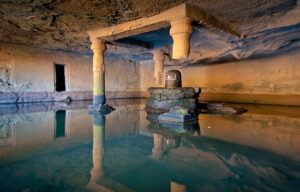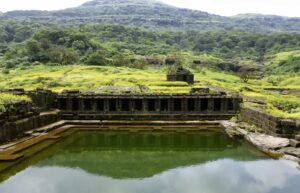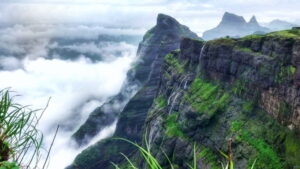Harishchandragad

Harishchandragad, a magnificent hill fort in Maharashtra’s Sahyadri range, is a paradise for adventure seekers and history enthusiasts. Standing tall at 4,670 feet, this ancient fort offers breathtaking views, challenging treks, and a rich historical legacy. The fort is home to the mesmerizing Konkan Kada, a cliff with a dramatic overhang, and the Taramati Peak, the highest point providing a panoramic view of the surrounding valleys.
Trekkers can choose multiple routes, from the easier Pachnai trail to the more challenging Nalichi Vaat. The Kedareshwar Cave Temple, with its sacred Shiva Linga surrounded by freezing water, adds a spiritual touch to the adventure. Camping under the starry sky enhances the experience, making it a perfect getaway for nature lovers.
Whether you’re an adrenaline junkie or a history buff, Harishchandragad promises an unforgettable journey through time, nature, and endurance. Conquer the heights and witness the glory of this legendary fort.
Harishchandragad of History and Mythology
Harishchandragad has a rich historical significance dating back to the 6th century during the Kalachuri dynasty. The fort is believed to have been built to guard ancient trade routes that connected Maharashtra’s coastal regions with the Deccan Plateau. Over the centuries, the fort has witnessed various rulers, including the Yadavas of Devagiri, Bahamanis, Mughals, and eventually the Marathas, who fortified and used it as a strategic military base.
The architectural remnants found within the fort complex indicate that it was an important religious and cultural hub in ancient times. The Harishchandreshwar Temple, dedicated to Lord Shiva, features intricate stone carvings and resembles the Hemadpanthi style of architecture, suggesting its association with the Rashtrakuta and Yadava periods. The presence of Buddhist caves within the fort further highlights its antiquity, as these caves are believed to have been carved by Buddhist monks during the Maurya or Satavahana reigns.
In Hindu mythology, Harishchandragad is linked to the legendary King Harishchandra, renowned for his unwavering commitment to truth and dharma. According to ancient scriptures, the king once ruled this region and underwent severe hardships to uphold his principles. The fort is said to have been named in his honor, and the Kedareshwar Cave Temple, which houses a massive Shiva Linga, is believed to be a sacred site associated with divine blessings.
The fort also holds significance in Puranic texts, particularly in the Skanda Purana and Matsya Purana, where it is described as a place of spiritual importance. Some legends suggest that sages and saints performed penance here, and the caves were used for meditation and religious rituals. The four pillars around the Kedareshwar Shiva Linga symbolize the four Yugas—Satya Yuga, Treta Yuga, Dwapara Yuga, and Kali Yuga. With three pillars already fallen, it is believed that when the fourth pillar collapses, it will mark the end of the current Kali Yuga.
The strategic location and naturally fortified terrain made Harishchandragad an important defensive stronghold in various battles. The Mughals, realizing its military importance, captured the fort in the 17th century, but it was later reclaimed by the Marathas under Shivaji Maharaj’s reign. The Marathas reinforced the fort’s defenses and used it as a watchtower to oversee enemy movements along the trade routes.
Today, Harishchandragad stands as a historical marvel, blending mythology, history, and natural beauty. The fort continues to attract history enthusiasts, trekkers, and spiritual seekers who wish to explore its ancient temples, caves, and breathtaking landscapes while unraveling the legends that surround this majestic stronghold.

Best Time to Visit Harishchandragad
Harishchandragad can be visited throughout the year, but each season offers a unique trekking experience.
Monsoon (June to September) – Lush Green Beauty with Waterfalls
During the monsoon season, the entire region transforms into a verdant paradise with mist-covered hills, gushing waterfalls, and refreshing streams. The fort and its surroundings come alive with a fresh green carpet, making it one of the most scenic times to visit. However, the trails become slippery, and trekking requires extra caution. The Konkan Kada is often covered in clouds, creating a mystical atmosphere, but visibility can be low. Waterproof gear and sturdy trekking shoes with good grip are highly recommended.
Winter (October to February) – Best Season for Trekking and Clear Views
Winter is considered the best season for trekking to Harishchandragad. The weather is cool and pleasant, making the trek comfortable even during the day. The skies are clear, providing stunning panoramic views from Taramati Peak and Konkan Kada. This is also the best time for overnight camping, as the nights are chilly but enjoyable with a bonfire. Trekkers should carry warm clothing, especially for night stays, as temperatures can drop significantly.
Summer (March to May) – Challenging Yet Rewarding
While summer is the least preferred season due to the heat, an early morning or night trek can still offer a fantastic experience. The trails are dry and clear, making navigation easier, but the sun can be harsh during midday. Trekkers should carry ample water, wear lightweight and breathable clothing, and start their trek before sunrise to avoid the heat. Night trekking is a great alternative during this season, as it provides a cool and serene experience under the starlit sky.
How to Reach Harishchandragad
By Road:
- From Mumbai (170 km): Take NH 160 via Malshej Ghat.
- From Pune (120 km): Take the route via Narayangaon or Malshej Ghat.
- From Ahmednagar (90 km): Travel via Akole to Khireshwar or Pachnai.
By Train:
- Nearest railway station: Igatpuri (around 40 km away)
- From Igatpuri, local transport is available to the base villages.
By Trekking Routes:
Harishchandragad has multiple trekking routes with varying difficulty levels:
- Khireshwar Route – Moderate trek (5-6 hours)
- Pachnai Route – Easiest trek (2-3 hours)
- Nalichi Vaat Route – Most challenging (7-8 hours)
Major Attractions at Harishchandragad

1. Konkan Kada – The Cliff of Wonders
The Konkan Kada (Konkan Cliff) is one of the most stunning and awe-inspiring spots at Harishchandragad. This natural concave rock formation stands at a sheer height of 1,800 feet, offering an unparalleled panoramic view of the Konkan region. The cliff’s curvature creates a unique floating cloud effect, where mist and clouds rise from below, giving visitors an ethereal experience. Trekkers and campers often gather here to witness breathtaking sunsets, where the sky paints a mesmerizing blend of orange, pink, and purple hues.
The Konkan Kada is a paradise for photographers, adventure enthusiasts, and those seeking solitude amidst nature. Many thrill-seekers even attempt rappelling and rock climbing along the cliff face, though extreme caution is required due to strong winds and unpredictable weather conditions.
2. Taramati Peak – Highest Point of the Fort
Standing tall at 4,670 feet (1,423 meters), Taramati Peak is the highest point of Harishchandragad. This peak offers a 360-degree panoramic view of the Sahyadri mountain ranges, including prominent peaks such as Kalsubai (Maharashtra’s highest peak), Ratangad, Alang-Madan-Kulang, and Pabhargad.
The trek to Taramati Peak is challenging, involving steep ascents, but the reward at the top is worth the effort. On a clear day, one can even spot forts like Rajmachi and Sinhagad from the summit. Taramati Peak is also an excellent location for astrophotography, as the night sky here is unpolluted, providing a perfect view of the Milky Way and constellations.
3. Kedareshwar Cave Temple – Sacred Shiva Temple
The Kedareshwar Cave Temple is one of the holiest sites on Harishchandragad, dedicated to Lord Shiva. The temple houses a massive 4-feet high Shiva Linga, which remains partially submerged in ice-cold water throughout the year. This ancient temple is built within a natural cave and exudes an aura of spiritual mysticism.
According to local legends, the temple has four supporting stone pillars, each representing one of the four Yugas (ages in Hindu mythology): Satya Yuga, Treta Yuga, Dwapara Yuga, and Kali Yuga. Interestingly, three of these pillars have already fallen, and it is believed that when the fourth pillar collapses, it will signify the end of Kali Yuga. The temple’s surrounding atmosphere is serene, attracting both devotees and history enthusiasts.
4. Caves and Ancient Temples
Harishchandragad is home to numerous ancient caves and temples, each holding historical and architectural significance. Some of the key sites include:
- Harishchandreshwar Temple – This magnificent temple is dedicated to Lord Shiva and is a fine example of Hemadpanthi architecture. The temple features intricate carvings, an idol of Lord Vishnu, and a Shiva Linga. The temple is believed to be over 1,000 years old and is an important pilgrimage site.
- Ganesh Caves – These small rock-cut caves are dedicated to Lord Ganesha and are often visited by trekkers seeking a moment of peace.
- Saptatirtha Pushkarini – A sacred pond surrounded by stone steps and ancient water reservoirs. It is said that the water in this pond was once crystal clear and used for religious ceremonies.
- Caves for Shelter – The fort has numerous caves scattered across the plateau, believed to have been used by monks, sages, and even soldiers in ancient times. Today, these caves serve as natural shelters for trekkers and campers.
Each of these attractions at Harishchandragad contributes to its mystique, making it an irresistible destination for trekkers, nature lovers, and history enthusiasts alike.

Trekking Experience and Camping
Harishchandragad is one of the most thrilling treks in Maharashtra, offering diverse trekking routes that cater to different experience levels. Beginners can take the Pachnai route, which is the easiest and shortest, while seasoned trekkers can challenge themselves with the Khireshwar or Nalichi Vaat routes, which involve steep rock climbs and technical sections. The trek rewards adventurers with breathtaking views, caves to explore, and the grandeur of the Konkan Kada cliff.
Many trekkers prefer to camp overnight near the fort to witness the mesmerizing sunrise from Konkan Kada. Camping under the starlit sky, surrounded by misty hills, is a surreal experience. The Taramati Peak, the highest point of the fort, offers a 360-degree panoramic view of the surrounding Sahyadri ranges, making it a perfect spot for photography enthusiasts.
Things to Carry for the Trek:
- Trekking shoes with a good grip – Essential for handling rocky and slippery terrains.
- Ample water (at least 2-3 liters per person) – There are limited water sources on the route.
- Energy snacks and dry fruits – To keep up stamina during the trek.
- Torchlight/headlamp with extra batteries – Crucial for night trekking and exploring caves.
- Sleeping bag/tent for camping – For a comfortable overnight stay.
- Warm clothes and windproof jacket – Nights can get chilly, especially in winter.
- First-aid kit and personal medications – Carry basic medical supplies, including antiseptic, bandages, and pain relievers.
- Raincoat or poncho (in monsoon season) – To stay dry during unexpected rain showers.
- Power bank – Mobile network is limited, so having a charged phone for emergencies is important.
- Plastic bags for waste – Help in keeping the fort clean by carrying back all waste.
Tips for a Safe and Enjoyable Trek
- Choose the right trekking route: If you’re a beginner, opt for the Pachnai route, which is the easiest. Experienced trekkers can take the Khireshwar or Nalichi Vaat route for a more challenging adventure.
- Always trek in a group: Trekking alone can be risky, especially on challenging routes. Group trekking ensures safety and support in case of emergencies.
- Avoid shortcuts and risky trails: Stick to the designated paths and avoid taking shortcuts, as these can be dangerous and lead to unexpected hazards.
- Respect nature and avoid littering: Carry biodegradable waste bags and take all trash back with you to preserve the beauty of Harishchandragad.
- Start early: Begin your trek early in the morning to avoid the afternoon heat and to ensure you return before sunset.
- Carry sufficient food and water: There are limited resources available at the top. Pack energy bars, dry fruits, and at least 2-3 liters of water per person.
- Dress appropriately: Wear comfortable, moisture-wicking clothing and sturdy trekking shoes with a good grip.
- Be prepared for changing weather conditions: Carry a raincoat during the monsoon and warm clothing during the winter months.
- Use trekking poles: A trekking pole can help maintain balance on rocky and steep sections.
- If trekking in the monsoon, be extra cautious: Trails become slippery, and strong winds can make climbing difficult. Avoid standing too close to the edge of cliffs, especially at Konkan Kada.
- Ensure mobile phone battery backup: Network coverage is limited, so carry a power bank for emergencies.
- Follow local guidelines and respect villagers: Many base villages have specific rules for trekkers, so follow their guidelines and respect their culture

Conclusion
Harishchandragad is not just a trekking destination; it is a journey through time, adventure, and natural beauty. This fort stands as a testament to history and nature’s grandeur, attracting thousands of adventure seekers every year. From navigating dense forests to conquering steep ascents, every step on this trek unfolds a new layer of thrill and wonder. Whether you’re hiking up Nalichi Vaat’s rocky patches, enjoying a relaxed climb via Pachnai, or pushing your endurance through Khireshwar, Harishchandragad has a trail suited for every trekker.
The historical significance of the Harishchandreshwar Temple and the Kedareshwar Cave adds a spiritual depth to this trek. The Konkan Kada’s mesmerizing cloud formations and the breathtaking view from Taramati Peak create an unforgettable visual spectacle. Camping under the star-lit sky, sitting by a warm bonfire, and waking up to a surreal sunrise make the entire journey even more magical.
This trek is more than just an adventure; it is a self-discovery experience that tests your endurance, rewards you with unparalleled natural beauty, and leaves you with a deep appreciation for history and culture. Whether you seek thrilling challenges, historical exploration, or serene camping under the stars, this fort offers it all. Plan your trek, experience the grandeur, and conquer the thrill of Harishchandragad! If you have visited this iconic fort, share your trekking experiences and tips in the comments below.

Harishchandragad Map
Follow More Fort







Recent Comments